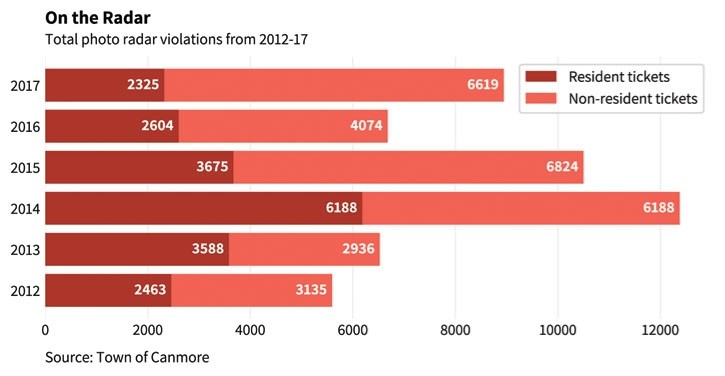CANMORE – After a decade of photo radar in the community, Canmore’s elected officials are keen to extend the program by another four years despite it being unpopular with some residents.
Originally launched in 2007 as a contracted operation, the current agreement in place expires Sept. 1, 2018 and council was asked at its May 1 regular meeting to set the direction of the program for the future.
Council voted unanimously to support putting the contract for the work out for a request for proposal process, with Mayor John Borrowman citing the program’s success at slowing down vehicle speeds as one of the reasons for the decision.
“I was on council when we first approved photo radar and I clearly remember the process council went through and the presentations from administration,” said the mayor.
“The whole focus was on slowing drivers down and, while it continues to be an unpopular program amongst a number of Canmore residents, I think the information we have developed, the data we have collected over the years, shows that we are being successful in that.”
Councillor Vi Sandford admitted when the program first began she regularly received speeding tickets from photo radar.
But Sandford said she has changed her behaviour and no longer receives fines.
“It isn’t that I know where the cars are, or what they look like,” she said. “It is that I have changed my behaviour.”
Sandford isn’t alone. Statistics from 2017 show that residents of the community only accounted for 26 per cent of tickets overall, compared to 39 per cent in 2016, 35 per cent in 2015 and 50 per cent in 2014.
“I think the consistency of the program over the last 10 years has probably affected that behaviour,” she said. “I do think it is a good program to support under the current conditions.”
In 2017, 8,944 photo radar tickets were issued. Since 2008, the number of tickets has ranged from a low of 5,302 in 2011 to 12,376 in 2014.
Manger of protective services Greg Burt said the program is managed by his department with the responsibility of operational direction being with the local RCMP detachment.
“The recommendation is council direct administration to issue an RFP for the provision of automated traffic enforcement services speed only for a four-year term,” Burt said.
The contract stipulates the contractor must provide fully trained peace officers, equipment, ticket process, court time, advertising, signage, statistics and a call centre.
Burt said RCMP determine the locations (40 sites currently), duration of times and speed threshold for the contractor as well and, on average, the program has resulted in a net revenue for the municipality of $300,000 a year, with $190,000 of that being used to pay for one RCMP member. Net revenues from 2007-17 were $3.32 million, with the balance in the photo radar reserve fund at the end of 2018 expected to be $358,950.
The program has paid for $851,006 in traffic safety initiatives such as the purchase of a radar speed trailer, vehicle activated traffic calming signals and pedestrian and cycling infrastructure. It has also paid for $545,960 in community safety initiatives and programs like rebates for youth that take driver training programs, community safety grants, and Cougar Creek parking and pathway improvements.
“I wanted to highlight and include in the report there have been discussions with the staff sergeant with regard to the program,” Burt said. “As the detachment commander who oversees the program, he is supportive of continuing the program.”
He said the RCMP continues to conduct traffic enforcement in the community and photo radar augments its program.
The alternate options in front of council were cancelling automated traffic enforcement altogether; bringing the service in-house and having bylaw department peace officers do the work; or discontinue the program and create a traffic enforcement unit consisting of community peace officers and RCMP.
“We shouldn’t get too hung up on the volume of fines issued, it is more about how successful we are at slowing down drivers,” Borrowman added. “When the RCMP were here in 2007 encouraging us to initiate photo radar, it was so they could free up their own staff to do community policing work rather than standing beside a road issuing tickets.”
At the same time, the province of Alberta has hired a consultant to conduct an independent review of automated traffic enforcement practices in Alberta and its guidelines.
Burt said Canmore has provided its data to the consultant, MNP/Tantus, and expects results to be available later this year.
In the RFP, Transportation Minister Brian Mason indicated the program should be focused on making streets and roads safer, not making money.
“There is a strong public view, I think, that photo radar has gone beyond just enforcing traffic safety and has become in some places a bit of a cash cow for municipalities and that is a misuse if it is occurring,” wrote Mason. “We need to know the degree to which that is occurring and correct that.”
Burt said if the province cancels photo radar as a result of the review, the new contract with a service provider would include language to allow the municipality to terminate the agreement without penalty.




